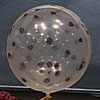-

-
Courses
Find courses by:
Collections
Cross-Disciplinary Topic Lists
- About
- Donate
- Featured Sites

 |
|
By the end of this lecture, you should:
› View/hide answer
In this case the observer is stationary so vr=0 and we will take the speed of sound vs as 340 m/s. The speed of the car vt is 50 km/hour = 50000m/3600s = 13.9 m/s, but the sign will change as it approaches and recedes. So \[f' = f\left( {\frac{{{v_s} - {v_r}}}{{{v_s} - {v_t}}}} \right) = 500\left( {\frac{{340}}{{340 \pm 13.8}}} \right)\]and when the car is approaching, the frequency will sound like 521 Hz and when receding, 480 Hz. Since, in the demo, a much smaller speed variation produced a detectable frequency change, this change would be very apparent.
› View/hide answer
Here θ=90º and \[\beta = \frac{{30 \times {{10}^3}}}{{3 \times {{10}^8}}} = {10^{ - 4}}\] Then \[\lambda ' = 3933.664\left( {\frac{1}{{\sqrt {1 - {{10}^{ - 8}}} }}} \right) = 3933.66402\] Even with the high precision that astronomers can attain, this relativistic effect would likely be too small to measure in this case.
› View/hide answer
It is likely most straightforward to use the wavelength form supplied. Since \(f\lambda = c\) we convert to a wavelength of \[\lambda = \frac{c}{f} = \frac{{3 \times {{10}^8}}}{{10.5 \times {{10}^9}}} = {\text{0}}{\text{.028571428}},\] where we have kept a lot of decimal places since we know the effect will be small and we assume that the original frequency is known very accurately (see below). To easily catch a speeder you likely have to be in front of them, so θ=0 and its cosine is 1. In the previous question we found that the denominator had little effect even at orbital speeds, so for cars it can be ignored. At 110 km/h we have \[\beta = \frac{{110 \times 1000/3600}}{{3 \times {{10}^8}}} = {\text{1}}{\text{.01851852}} \times {\text{1}}{{\text{0}}^{{\text{ - 7}}}}.\] Keeping in mind the factor of 2 (the radar beam is shifted as viewed from the speeding car and the reflected beam is shifted again as viewed from the police car), we then get \[\lambda ' = \lambda \left( {1 - 2\beta } \right){\text{ = 0}}{\text{.028571428(1 - 2}}{\text{.03703704e - 7}}) = {\text{0}}{\text{.028571422}}.\] Converting back to frequency we get \[f = \frac{c}{\lambda } = \frac{{3 \times {{10}^8}}}{{{\text{0}}{\text{.028571425}}}} = {\text{10500002348}}Hz\] or 10.5 GHz + 2348 Hz. This may seem impossible to detect, but look what has happened. A microwave signal has been reflected at a very slightly different frequency. This is ideal for making beats if part of the outgoing signal is combined with the received signal, and the beat frequency is in the easily detected audio range. In fact, the beats approach even means that the outgoing signal frequency need not be very precisely maintained. Police radar is more evidence that physics works, no matter how painful!